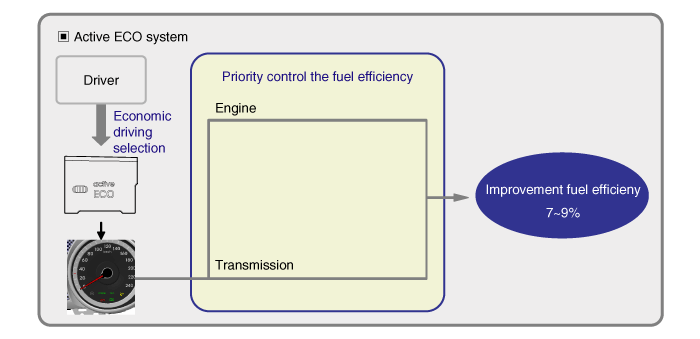| 1. |
Active ECO System
While the general eco system encourages the
driver to drive efficiently by displaying ECO lights on the
dashboard, the active ECO system controls the transmission forcibly
to achieve fuel efficiency. The driver can activate the active ECO
button on the steering wheel to engage this mode. If the active ECO
is selected, then the engine and transmission are controlled with
priority placed on fuel efficiency. It achieves even greater fuel
economy than the conventional system. The active ECO system may not
engage under certain conditions. (e.g., when driving up an incline
or before the engine is warmed up). If active ECO is not selected,
then the general ECO System can be selected and
engaged. |
| 2. |
Active ECO Features
| -
|
Minimizes fuel consumption caused by
unnecessary acceleration:
Limits engine torque during acceleration
(disengages limit control when starting to move or
accelerating suddenly to ensure trouble-free
performance). |
| -
|
Lowers the up shift vehicle speed:
Lowers engine RPM when
driving. |
| -
|
Prevents down shift if possible:
Prevents driving under high engine
RPM. |
| -
|
Expands the direct connection area of
the torque converter.

|
Inform the driver that the
following conditions are not malfunctions.
| 1. |
The active ECO system
provides improved fuel efficiency through direct
control of the engine / transmission, but the
actual fuel saved may be less than you expect,
depending on the driving conditions and the
driver's driving
habits. |
| 2. |
The active ECO limits
acceleration on flat ground to conserve fuel, but
this feature is disengaged when driving up an
inclined road. |
| 3. |
When a driver activates the
active ECO System, the mode is maintained until
the driver deactivates the
system. |
| 4. |
The conventional eco driving
notices are not activated when active ECO is on.
However, a green lamp on the dashboard is
permanently on. (The constant on state of the
green lamp signifies that the active ECO system is
currently
engaged.) | | | |
| 3. |
Conditions That Prevent Active ECO System
Engagement
| (1) |
Active ECO is not active when the
coolant temperature falls below the preset
level. |
| (2) |
Active ECO is not active if the APS
opening is maintained for longer than the preset
limit. |
| (3) |
Active ECO is not active if the check
engine lamp is blinking. |
| (4) |
Active ECO is not active if a CAN error
message occurs. |
| (5) |
Active ECO is not active if a deactivate
signal is triggered by the
TCU. |
| (6) |
Active ECO is not active if VDC is
engaged. |
| (7) |
Active ECO is not active if pattern is
switched to other than the normal or active ECO transmission
pattern. | | |